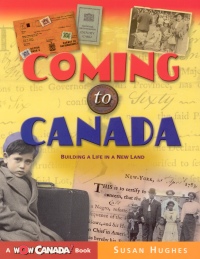| ________________
CM . . .
. Volume XII Number 7 . . . .November 25, 2005
excerpt:
Coming to Canada details the mosaic that makes up Canada. Canada is a land of immigration that began over 30,000 years ago and continues to the present day. The book is divided into four sections: “Building a Nation,” “Going West,” “A New Century,” and finally “The Changing Face of Canada.” Each section depicts how immigrants shaped and built Canada into the great country it is today. The stories also show that it was not smooth sailing for a lot of the people who first came to these shores. The start of the book explains the arrival of the native people to Canada and the different theories of how they came to be Canada’s first immigrants. “Building a Nation” explores the arrival of the King’s Daughters, the Loyalists, the role of Underground Railroad, and the arrival of the Irish. “Going West” describes the hardships endured by the Chinese as they built the railroads that joined Canada. It then goes on to show the contributions made by the Icelandic, Ukrainian, and Italian immigrants to Canada. “A New Century” depicts some of Canada’s treatment of immigrants to its shores from the “Komagata Maru Incident” to the interment of Canadian born Japanese in the Second World War. On a more positive note, it shows the arrival of the war brides to Canada at the end of World War II and how they influenced Canadian culture. The last section, “Changing Face of Canada,” describes to students the arrival of immigrants from countries that were at war or experiencing civil war, such as Hungary, Afghanistan, The United States of America, and Somali. Coming to Canada is based on true stories of the immigrants involved. These stories are interspersed with photographs, documents, tickets, tools, etc., all of which make the book an attractive read. The book also contains an index and further Internet resources related to the immigration topic. An important tool is the timeline at the back of the book. It will be needed by students to show how and where these stories fit into the historical context of Canada. Susan Hughes is a writer and editor who lives in Toronto with her family. She has been writing children’s fiction and non-fiction books for the last 20 years. She has been shortlisted for the Hackmatack Award and the Red Cedar Book Award for her book Canada Invents (Maple Tree Press, 2002). Recommended. Jean Nickel is a library technician at the Westglen School in Didsbury, AB.
To comment
on this title or this review, send mail to cm@umanitoba.ca.
Copyright © the Manitoba Library Association. Reproduction for personal
use is permitted only if this copyright notice is maintained. Any
other reproduction is prohibited without permission.
NEXT REVIEW |
TABLE OF CONTENTS FOR THIS ISSUE
- November 25, 2005.
AUTHORS |
TITLES |
MEDIA REVIEWS |
PROFILES |
BACK ISSUES |
SEARCH |
CMARCHIVE |
HOME |
